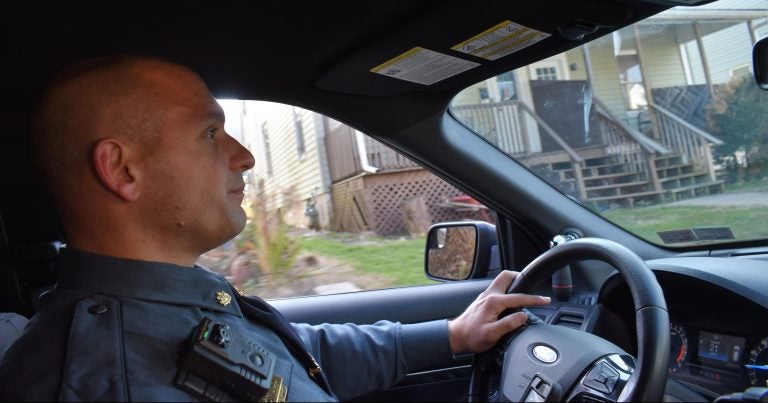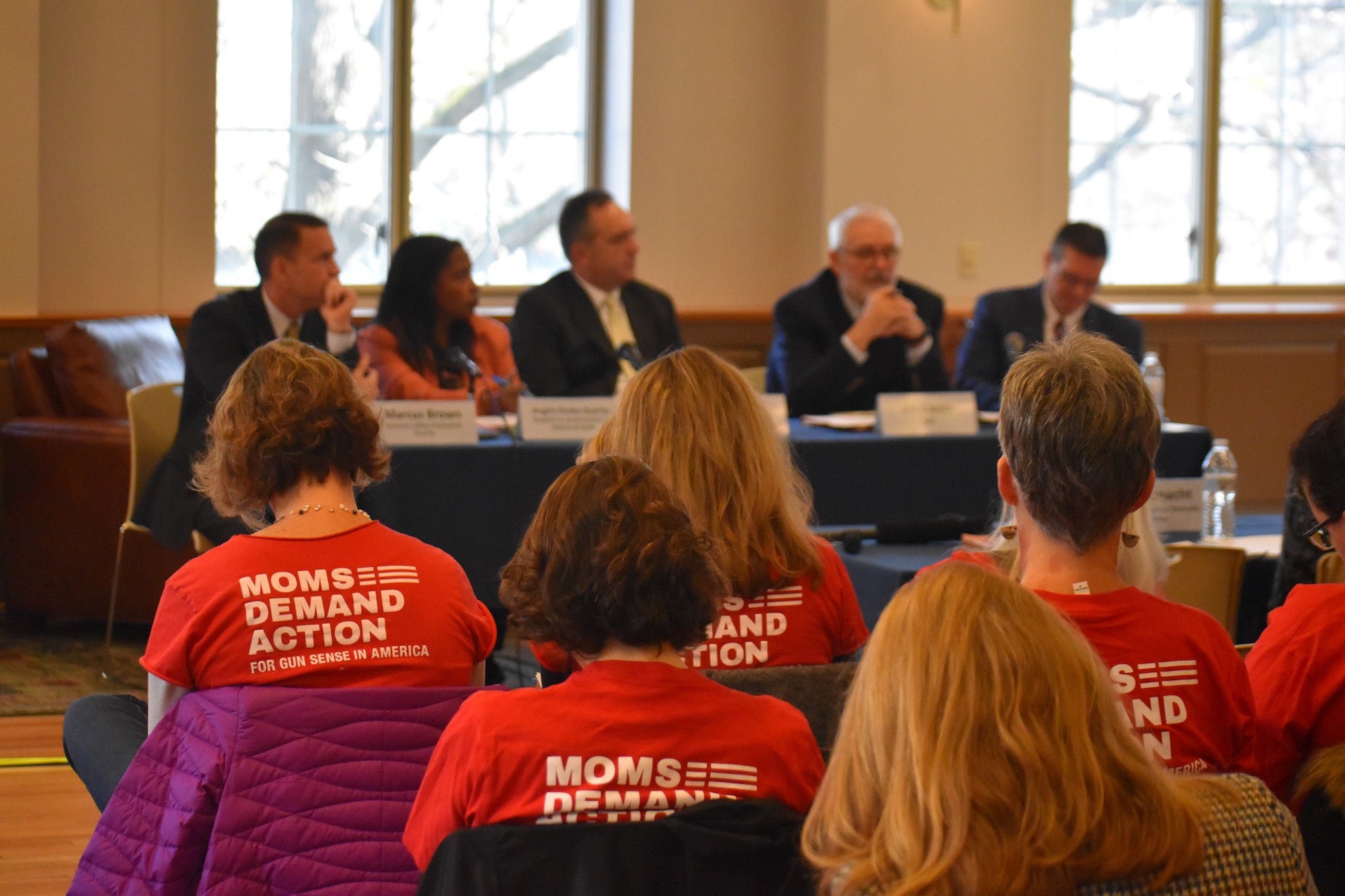Coatesville police say 11 questions can reduce domestic violence. Why aren’t more officers asking them?
The program connects high-risk victims with an advocate.

Corporal Paul Antonucci drives back to the City of Coatesville Police Department headquarters after responding to a report of unattended children on Nov. 19, 2019. (Ed Mahon/PA Post)
This article originally appeared on PA Post.
—
For the first 15 years that Rodger Ollis worked as a police officer, he walked away from a lot of domestic abuse calls wondering if he had done enough.
He wondered if he’d be back to the same home in a few days or hours.
Sometimes it was the victim who called police, other times a neighbor. Responding to these calls often put officers in the middle of volatile situations, with plenty of yelling and crying.

Sometimes there wasn’t enough evidence to arrest a suspected abuser. The criminal code, Ollis likes to say, is really good at handling a punch. But other types of abuse — emotional, financial — are harder to see and don’t always rise to a criminal level.
And even if he did arrest someone, Ollis said he didn’t know if the victim would reach out to a domestic violence program for help, if they would have the support to leave a relationship and move on with their life.
Then, about seven years ago, he learned how to use a new tool — the Lethality Assessment Program.
There’s a lot of research behind it, but the sheet that Ollis and his fellow officers use to apply it to a domestic violence situation is short — just one page with 11 questions, plus space for victims to describe any other safety worries.
Ollis said the tool takes about five to 10 minutes to go through at the scene. And he said the process makes a big difference.
“It was the first time that I ever had an opportunity to prevent a homicide as opposed to just giving the victim a pamphlet,” said Ollis, a sergeant with the Coatesville Police Department in western Chester County.
Since the Pennsylvania Coalition Against Domestic Violence launched the Lethality Assessment Program in 2012, the group says it has helped suspected abuse victims speak with a domestic violence advocate or obtain other help more than 10,000 times.
Those advocates then help victims create safety plans, find emergency shelter, apply for protective orders, receive counseling and more.
Lois Fasnacht, a training specialist with the Pennsylvania Coalition Against Domestic Violence, said police and advocates give a warning to people flagged by the assessment as being at a high risk of violence at the hands of their abuser.
“They are told people in your situation have been killed. …Nobody’s probably ever said that to a victim,” Fasnacht said.
Nearly every police department in Chester County uses the screening tool. The program has expanded each year since 2012 and is now used in 49 out of 67 counties and by more than 360 police departments. Several rural counties, including Potter and Elk in north central Pennsylvania, added the program last year.
How the program came to Pennsylvania
The Lethality Assessment Program began in Maryland in 2005, based on the research of Jacquelyn Campbell at the John Hopkins School of Nursing and others.
Reachers found that abuse victims rarely used a domestic violence hotline or shelter within a year before they were killed
But the research found nearly half of abusers had been arrested in the year before killing an intimate partner, and almost one third of victims had contacted police in that year.
For domestic violence advocates, those stats documented many missed opportunities to identify victims in danger of being killed.
Coatesville joined an early pilot program in 2012. Police officers use the screening tool for intimate partners or former intimate partners.

The department receives around 850 domestic disturbance calls a year, Ollis said. The lethality assessment tool is used in about 10 percent of those cases.
Officers will use the tool if they see signs of an assault, find that a protective order has been violated, in cases of stalking and harassment, or similar situations, Ollis said.
If someone answers yes to any of the first three questions, the police automatically flag them as being in high danger. Those questions are:
- Have they [the alleged abuser] ever used a weapon against you or threatened you with a weapon?
- Have they threatened to kill you or your children?
- Do you think they might try to kill you?
If the victim answers “yes” to at least four of the remaining 11 questions, the victim is also considered to be at high risk.
- Do they [the abuser] have a gun or can they easily get one?
- Have they ever tried to choke you?
- Are they violently or constantly jealous or do they control most of your daily activities?
- Have you left them or separated after living together or being married?
- Is the abuser unemployed?
- Has the abuser ever tried to kill themself?
- Do you have a child that they know is not theirs?
- Do they follow or spy on you or leave threatening messages?
(The assessment includes he/she/they versions of each question.)
There are two additional questions that give suspected victims the opportunity to add anything else that worries them. Even if victims respond with a “no” to all the questions, officers could decide they are in a potentially lethal situation and decide to flag them as being at high risk.
“I tell officers that there’s no harm in calling [the hotline]. There could be harm in not. So trust their gut,” Ollis said.
Once police call the hotline, it’s up to the victims whether or not they want to speak to an advocate.
Ashley Folchman, coordinator of the Lethality Assessment Program for the Domestic Violence Center of Chester County, said an officer’s involvement can help break through a barrier for victims.
“For a lot of victims, they might have thought about leaving the relationship prior to that 911 call. For that victim, they might have looked up the (domestic violence) center on their own but been too afraid to call,” she said.
During the most recent fiscal year, police in Chester County screened people 425 times with the assessment. They flagged someone as being in high danger 244 times, and those high-risk victims spoke with a hotline representative 126 times.

Coatesville, a city of 13,000 with about 35 police officers, used the screening questions more often than any other agency in the county.
The program doesn’t focus on rehabilitating or punishing the alleged abusers. Instead, it focuses on ways to keep victims safe and to help them move on from a dangerous relationship. Ollis said the quick pass off to an advocate can help get at root problems, whereas simply arresting the abuser often may not.
“In many cases there are arrests. But arrests are a result. It’s not necessarily the answer,” Ollis said.
He said victims need to be empowered, cared for and counseled as “part of the process of making them whole again.”
Why state police don’t use the program
In the fall of 2017, the Pennsylvania Coalition Against Domestic Violence released a report looking at the five-year impact of the program, which is often called LAP. The group identified expanding its use to more rural counties as a key goal.
“This goal will require the Pennsylvania State Police to adopt the LAP,” the report said. “Once the program is available throughout the state, we can fully ascertain the impact that LAP has on reducing intimate partner homicides.”
But efforts to recruit the Pennsylvania State Police and its more than 4,400 troopers and officers into the program have hit a brick wall, even as Fasnacht noted that state police officers have sat in on the coalition’s training program.
“They heard from local law enforcement about how they want the state police to participate,” Fasnacht said during a gun violence hearing in State College in November. “And nothing then happens. …It gets a little frustrating for us — that sometimes we take a breather.”
State police officials say following one single process isn’t feasible because its officers cover such a large and geographically diverse area — more than 80 percent of the state’s landmass, with full- or part-time coverage in more than 1,700 municipalities.
In a statement, spokesman Ryan Tarkowski said the agency “supports the work” of Fasnacht’s group, and he emphasized all the hands-on domestic violence training that cadets and troopers already receive.
But he said it’s not always possible to connect a victim with a crisis worker. There’s unreliable cell service in some parts of the state. And he said each of the state’s 67 counties have different levels of service available to victims — particularly during non-business hours.

Why other departments don’t use the program
While state police agreeing to join the program would bring a major expansion, there are still a lot of other law enforcement agencies in Pennsylvania to recruit.
The Pennsylvania Department of Community and Economic Development says there are more than 1,200 traditional, regional and other departments in the state.
Several years ago, a report from the U.S. Department of Justice said Pennsylvania has the most local police departments among the 50 states.
Fasnacht hears two main reasons why police departments don’t want to use the program: Time and phones.

Some police departments say their officers are already overstretched and they worry the program will take up too much time.
Fasnacht disputes that idea.
“It doesn’t. Not at all,” she said during the gun violence hearing in State College. “Our hotline advocates know that phone call cannot be any longer than 10 minutes.”
In Pittsburgh, for instance, Police Sgt. Eric Kroll said officers use a system that, start to finish, takes less than 15 minutes. Officers there have the screening tool set up as a mobile app.
And he said the time investment is worth it: Victims are more likely to show up for court proceedings, and connecting a victim with an advocate is more likely to lead to a permanent solution. That means it’s less likely police will have to return to a home multiple times for ongoing domestic disturbance calls, Kroll said.
But, as for the other main concern of departments, solutions vary.
Equipping officers with cell phones to conduct the assessment is an added cost to department budgets, but some see it as a negligible cost. Pittsburgh, a department with about 900 officers, estimates it costs about $20,000 a year for cell phone and cell phone coverage for the Lethality Assessment Program.
Spokesperson Cara Cruz said the department “maintains that the benefits of providing victims of domestic violence with what could be potentially life-saving technology far outweigh any costs incurred by the City of Pittsburgh.”
In Coatesville, officers sometimes use a victim’s cell phone to make a call — and then encourage them to delete the call history, in case their abuser later looks at the call log.
The idea of using a victim’s cell phone is one that Fascnacht was initially reluctant to embrace. She and others with the coalition had concerns about an abuser finding out about the call.
But after watching that approach in practice, she changed her mind.
Victims told advocates that since the police were already involved in the situation, abusers were already mad. Calling a hotline seemed unlikely to make the abuser significantly angrier, she said.

What’s next
The lethality assessment issue came up during one of five regional gun violence hearings organized by the state’s Special Council on Gun Violence.
Council member Angela Parker-Quarles asked about resistance to using the program.
Parker-Quarles’s goddaughter was stabbed and shot to death by the goddaughter’s estranged husband eight years ago, and she’s now an advocate on victim rights issues.
Parker-Quarles would like to see the Lethality Assessment Program used across Pennsylvania.
“I think that if they put people at the center and at the focus, and more importantly victims at the center and at the focus, they would find themselves leaning towards the LAP,” she said.
The council plans to make its recommendations in March, and it could take on the lethality assessment issue.
But there’s one recommendation Fasnacht hopes they don’t make: Making the program mandatory for all police departments.
The coalition opposed 2017 legislation, introduced by state Rep. Kate Klunk, R-York, aimed at expanding the program.
The bill, named after two women killed by an abuser in York County in 2015, would have required all police officers to receive training for assessing the lethality risk of domestic violence incidents. It also would have created an annual $2 million grant for law enforcement. Klunk, in pushing the bill, said Maryland saw domestic violence deaths drop in the years after it introduced the Lethality Assessment Program.
“That to me is pretty common sense, that this program needs to be implemented across Pennsylvania,” Klunk said.
Fasnacht agrees with the goal of expanding the program. But she wants law enforcement agencies to sign up for it voluntarily. The program works best that way, she said. And if it’s not voluntary, she said officers might push back too much and some might just check a box saying victims declined to be screened.
That means winning over departments and officers one by one — officers like Corporal Paul Antonucci in Coatesville. He thinks other departments should give it a try.
“Why wouldn’t you? It can’t hurt,” he said. “It’s not going to hurt your department.”

WHYY is your source for fact-based, in-depth journalism and information. As a nonprofit organization, we rely on financial support from readers like you. Please give today.




